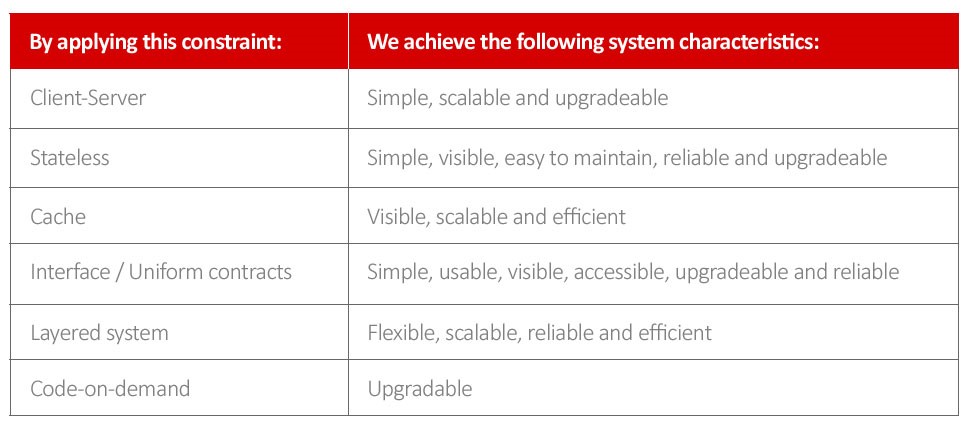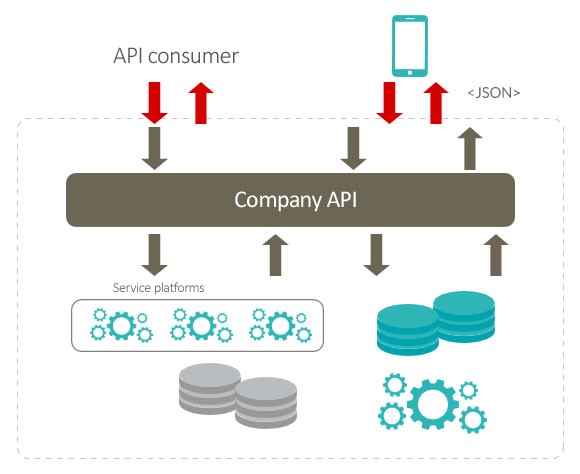A RESTful design improves API performance, reduces development efforts and decreases the necessary operational support through the development of web applications, web services and web APIs. With proven RESTful constraints, teams may create scalable, omnipresent, prolific systems.
REST requires a new development mentality, which is why many API implementations are not really based on REST constraints or principles, nor do they fulfil scalability, upgradeability and interoperability expectations. If we follow good practices and work with RESTful tools, the teams may easily design, upgrade and connect RESTful APIs.
REST constrains the system to:
- Client-server interactions
- Stateless communications
- Cacheable data
- Uniform interfaces
- Layered systems
- Code-on-demand
-You might be interested in: REST vs SOAP-
Each constraint adds advantageous properties for the web system. By implementing constraints, teams may build simple, reliable, feasible, usable, accessible systems which are upgradeable and easy to maintain. In the following table we can see how REST constraints can improve the properties of our system for us:

Tabla 1: REST Constraints and System Properties
When developing APIs, web applications or web services, developers unevenly apply REST constraints. For example, one web application may have code-on-demand (e.g., client-side JavaScript), layered system design and client-server interactions, but on the other hand, it may not uniformly implement interfaces and cacheable data.
“If the ‘back’ button doesn’t work, your web application or API is not fully RESTful.”
APIs may implement uniform interfaces, client-server interactions and layered systems, but may not implement stateless communications or cacheable data. If your API client needs to be associated with a sticky session, or if your server does not check the last modified header before responding, your API is not completely RESTful.
Stateless communications
When communications are stateless, each request takes place in isolation, and the client is responsible for maintaining the state. The client request contains all of the information required in the request process, and a RESTful server does not keep local state information of past requests.
A trial by fire for stateless communications is disabling session cookies and determining whether the API or web service are still working as intended.
RESTful APIs, services and applications may still expose states. However, the state information must be embedded in hyperlink representations (e.g., URLs, hrfs messages). By explicitly transferring the client’s status, the response message comes explicitly from a valid operational path through the system to the end client.
With stateless communications, the context shared temporarily is not stored by the server. Because the temporary state context needs to be sent repeatedly in requests, stateless communications increases network traffic. But with an increase in network connectivity, the benefits are more important than the costs.
Cacheable data
RESTful systems identify data as cacheable and respect cache tags. Cacheable data reduces network traffic and reduces the load on the back-end system. Intermediate nodes may return cached data in favor of back-end servers, increasing scalability, availability, reliability, and performance. In a RESTful system, intermediaries recognize new information, idempotent operations (e.g., GET) and schema versioning.
Uniform interfaces
While the uniform interface constraint is the most decisive and visible REST constraint, it is commonly the reason why RESTful principles and techniques are not completely complied with.
Uniform interfaces:
- Identify resources
- Manipulate resources through representations
- Display self-descriptive messages
- Rely on Hypermedia As The Engine Of Application State (HATEOAS)
Uniform interfaces should identify the behavior and semantics of the message without looking into the message body. The URL or URI must declare that the resource is being manipulated. Uniform interfaces do not depend from the state of the message stored. Uniform interfaces are based on standard messages (e.g., GET, HEAD, POST, DELETE) and communicate process media type information.
When applying REST constraint layers over HTTP and URLs, RESTful systems are optimized through the transfer of hypermedia data, even if they are suboptimal for other interactions.
Layered systems
Through the creation of layered systems, teams may upgrade client and server components independently. An API design pattern (API Façade) hides the complexity of the internal implementation and presents a simple interface to consumers. Simple RESTful API interfaces hide multiple back-end databases and additional services (see Figure 1).
Through the use of an API design pattern (API Façade), the teams will be able to easily connect to existing systems by using complex meditation techniques, but also by offering a simple, friendly API to consumers. Under the hood, the solution may splice and orchestrate services and transform messages.
The API design pattern (API Façade) enables teams to scale each layer of the architecture independently, and apply infrastructure policies (e.g., Authorizations, authentications, response times, and rate limits) per system service or API. API Façade may limit the complexity of the system and even simplify even further the complexity of the integration by applying RESTful principles and constraints to the API’s design pattern.
Figure 1: API Façade pattern
Code-on-Demand
Code-on-Demand allows clients to extend functionalities through by downloading and executing code locally. By enabling Code-on-Demand, the system decreases the number of required pre-implemented characteristics and improves system upgradeability. Downloading and executing JavaScript on the client side or in plugins within a server or the REST client, we comply with REST constraints.
The use of REST constraints can make our team’s work much easier and improve our systems considerably. A RESTful design will make our APIs and web services more efficient, and we will also reduce development efforts considerably. Do you want to achieve a RESTful design? Download our guide.







